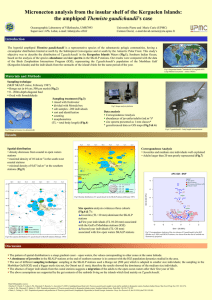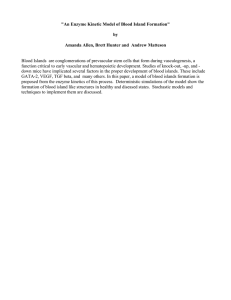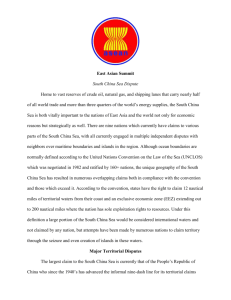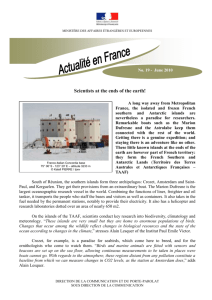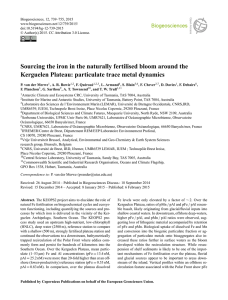Micronecton analysis from the insular shelf of the Kerguelen islands:
advertisement
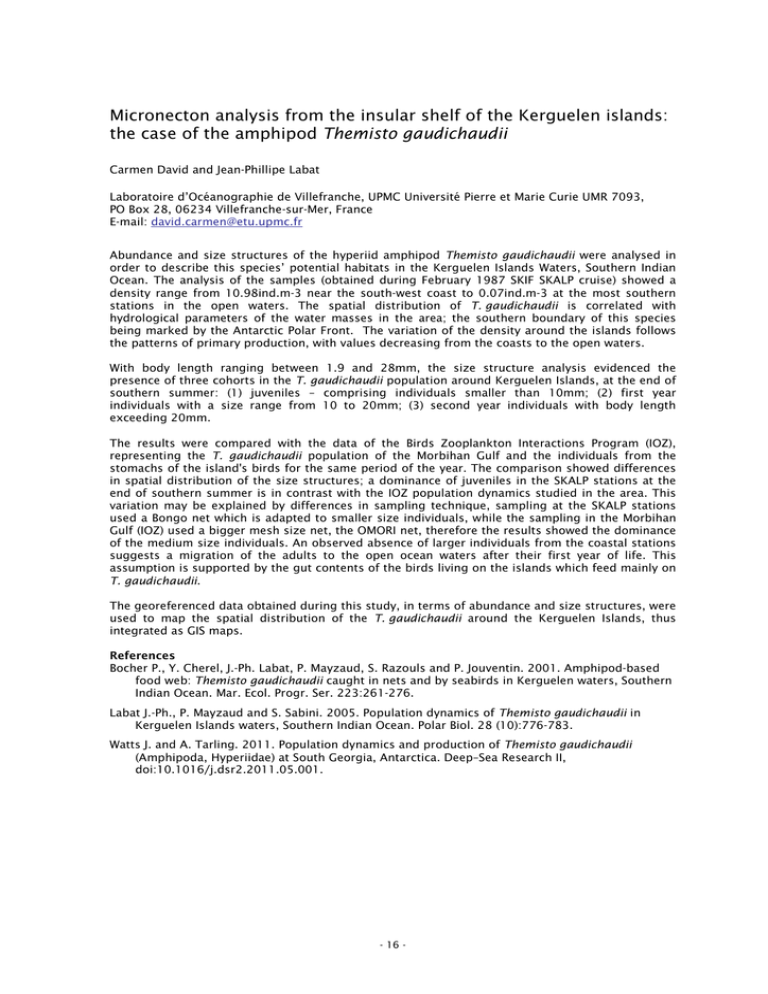
Micronecton analysis from the insular shelf of the Kerguelen islands: the case of the amphipod Themisto gaudichaudii Carmen David and Jean-Phillipe Labat Laboratoire d’Océanographie de Villefranche, UPMC Université Pierre et Marie Curie UMR 7093, PO Box 28, 06234 Villefranche-sur-Mer, France E-mail: david.carmen@etu.upmc.fr Abundance and size structures of the hyperiid amphipod Themisto gaudichaudii were analysed in order to describe this species’ potential habitats in the Kerguelen Islands Waters, Southern Indian Ocean. The analysis of the samples (obtained during February 1987 SKIF SKALP cruise) showed a density range from 10.98ind.m-3 near the south-west coast to 0.07ind.m-3 at the most southern stations in the open waters. The spatial distribution of T. gaudichaudii is correlated with hydrological parameters of the water masses in the area; the southern boundary of this species being marked by the Antarctic Polar Front. The variation of the density around the islands follows the patterns of primary production, with values decreasing from the coasts to the open waters. With body length ranging between 1.9 and 28mm, the size structure analysis evidenced the presence of three cohorts in the T. gaudichaudii population around Kerguelen Islands, at the end of southern summer: (1) juveniles – comprising individuals smaller than 10mm; (2) first year individuals with a size range from 10 to 20mm; (3) second year individuals with body length exceeding 20mm. The results were compared with the data of the Birds Zooplankton Interactions Program (IOZ), representing the T. gaudichaudii population of the Morbihan Gulf and the individuals from the stomachs of the island's birds for the same period of the year. The comparison showed differences in spatial distribution of the size structures; a dominance of juveniles in the SKALP stations at the end of southern summer is in contrast with the IOZ population dynamics studied in the area. This variation may be explained by differences in sampling technique, sampling at the SKALP stations used a Bongo net which is adapted to smaller size individuals, while the sampling in the Morbihan Gulf (IOZ) used a bigger mesh size net, the OMORI net, therefore the results showed the dominance of the medium size individuals. An observed absence of larger individuals from the coastal stations suggests a migration of the adults to the open ocean waters after their first year of life. This assumption is supported by the gut contents of the birds living on the islands which feed mainly on T. gaudichaudii. The georeferenced data obtained during this study, in terms of abundance and size structures, were used to map the spatial distribution of the T. gaudichaudii around the Kerguelen Islands, thus integrated as GIS maps. References Bocher P., Y. Cherel, J.-Ph. Labat, P. Mayzaud, S. Razouls and P. Jouventin. 2001. Amphipod-based food web: Themisto gaudichaudii caught in nets and by seabirds in Kerguelen waters, Southern Indian Ocean. Mar. Ecol. Progr. Ser. 223:261-276. Labat J.-Ph., P. Mayzaud and S. Sabini. 2005. Population dynamics of Themisto gaudichaudii in Kerguelen Islands waters, Southern Indian Ocean. Polar Biol. 28 (10):776-783. Watts J. and A. Tarling. 2011. Population dynamics and production of Themisto gaudichaudii (Amphipoda, Hyperiidae) at South Georgia, Antarctica. Deep–Sea Research II, doi:10.1016/j.dsr2.2011.05.001. - 16 -
